Chapter 16: The Expanding Universe
Chapter 1
How Science Works
- The Scientific Method
- Evidence
- Measurements
- Units and the Metric System
- Measurement Errors
- Estimation
- Dimensions
- Mass, Length, and Time
- Observations and Uncertainty
- Precision and Significant Figures
- Errors and Statistics
- Scientific Notation
- Ways of Representing Data
- Logic
- Mathematics
- Geometry
- Algebra
- Logarithms
- Testing a Hypothesis
- Case Study of Life on Mars
- Theories
- Systems of Knowledge
- The Culture of Science
- Computer Simulations
- Modern Scientific Research
- The Scope of Astronomy
- Astronomy as a Science
- A Scale Model of Space
- A Scale Model of Time
- Questions
Chapter 2
Early Astronomy
- The Night Sky
- Motions in the Sky
- Navigation
- Constellations and Seasons
- Cause of the Seasons
- The Magnitude System
- Angular Size and Linear Size
- Phases of the Moon
- Eclipses
- Auroras
- Dividing Time
- Solar and Lunar Calendars
- History of Astronomy
- Stonehenge
- Ancient Observatories
- Counting and Measurement
- Astrology
- Greek Astronomy
- Aristotle and Geocentric Cosmology
- Aristarchus and Heliocentric Cosmology
- The Dark Ages
- Arab Astronomy
- Indian Astronomy
- Chinese Astronomy
- Mayan Astronomy
- Questions
Chapter 3
The Copernican Revolution
- Ptolemy and the Geocentric Model
- The Renaissance
- Copernicus and the Heliocentric Model
- Tycho Brahe
- Johannes Kepler
- Elliptical Orbits
- Kepler's Laws
- Galileo Galilei
- The Trial of Galileo
- Isaac Newton
- Newton's Law of Gravity
- The Plurality of Worlds
- The Birth of Modern Science
- Layout of the Solar System
- Scale of the Solar System
- The Idea of Space Exploration
- Orbits
- History of Space Exploration
- Moon Landings
- International Space Station
- Manned versus Robotic Missions
- Commercial Space Flight
- Future of Space Exploration
- Living in Space
- Moon, Mars, and Beyond
- Societies in Space
- Questions
Chapter 4
Matter and Energy in the Universe
- Matter and Energy
- Rutherford and Atomic Structure
- Early Greek Physics
- Dalton and Atoms
- The Periodic Table
- Structure of the Atom
- Energy
- Heat and Temperature
- Potential and Kinetic Energy
- Conservation of Energy
- Velocity of Gas Particles
- States of Matter
- Thermodynamics
- Entropy
- Laws of Thermodynamics
- Heat Transfer
- Thermal Radiation
- Wien's Law
- Radiation from Planets and Stars
- Internal Heat in Planets and Stars
- Periodic Processes
- Random Processes
- Questions
Chapter 5
The Earth-Moon System
- Earth and Moon
- Early Estimates of Earth's Age
- How the Earth Cooled
- Ages Using Radioactivity
- Radioactive Half-Life
- Ages of the Earth and Moon
- Geological Activity
- Internal Structure of the Earth and Moon
- Basic Rock Types
- Layers of the Earth and Moon
- Origin of Water on Earth
- The Evolving Earth
- Plate Tectonics
- Volcanoes
- Geological Processes
- Impact Craters
- The Geological Timescale
- Mass Extinctions
- Evolution and the Cosmic Environment
- Earth's Atmosphere and Oceans
- Weather Circulation
- Environmental Change on Earth
- The Earth-Moon System
- Geological History of the Moon
- Tidal Forces
- Effects of Tidal Forces
- Historical Studies of the Moon
- Lunar Surface
- Ice on the Moon
- Origin of the Moon
- Humans on the Moon
- Questions
Chapter 6
The Terrestrial Planets
- Studying Other Planets
- The Planets
- The Terrestrial Planets
- Mercury
- Mercury's Orbit
- Mercury's Surface
- Venus
- Volcanism on Venus
- Venus and the Greenhouse Effect
- Tectonics on Venus
- Exploring Venus
- Mars in Myth and Legend
- Early Studies of Mars
- Mars Close-Up
- Modern Views of Mars
- Missions to Mars
- Geology of Mars
- Water on Mars
- Polar Caps of Mars
- Climate Change on Mars
- Terraforming Mars
- Life on Mars
- The Moons of Mars
- Martian Meteorites
- Comparative Planetology
- Incidence of Craters
- Counting Craters
- Counting Statistics
- Internal Heat and Geological Activity
- Magnetic Fields of the Terrestrial Planets
- Mountains and Rifts
- Radar Studies of Planetary Surfaces
- Laser Ranging and Altimetry
- Gravity and Atmospheres
- Normal Atmospheric Composition
- The Significance of Oxygen
- Questions
Chapter 7
The Giant Planets and Their Moons
- The Gas Giant Planets
- Atmospheres of the Gas Giant Planets
- Clouds and Weather on Gas Giant Planets
- Internal Structure of the Gas Giant Planets
- Thermal Radiation from Gas Giant Planets
- Life on Gas Giant Planets?
- Why Giant Planets are Giant
- Gas Laws
- Ring Systems of the Giant Planets
- Structure Within Ring Systems
- The Origin of Ring Particles
- The Roche Limit
- Resonance and Harmonics
- Tidal Forces in the Solar System
- Moons of Gas Giant Planets
- Geology of Large Moons
- The Voyager Missions
- Jupiter
- Jupiter's Galilean Moons
- Jupiter's Ganymede
- Jupiter's Europa
- Jupiter's Callisto
- Jupiter's Io
- Volcanoes on Io
- Saturn
- Cassini Mission to Saturn
- Saturn's Titan
- Saturn's Enceladus
- Discovery of Uranus and Neptune
- Uranus
- Uranus' Miranda
- Neptune
- Neptune's Triton
- Pluto
- The Discovery of Pluto
- Pluto as a Dwarf Planet
- Dwarf Planets
- Questions
Chapter 8
Interplanetary Bodies
- Interplanetary Bodies
- Comets
- Early Observations of Comets
- Structure of the Comet Nucleus
- Comet Chemistry
- Oort Cloud and Kuiper Belt
- Kuiper Belt
- Comet Orbits
- Life Story of Comets
- The Largest Kuiper Belt Objects
- Meteors and Meteor Showers
- Gravitational Perturbations
- Asteroids
- Surveys for Earth Crossing Asteroids
- Asteroid Shapes
- Composition of Asteroids
- Introduction to Meteorites
- Origin of Meteorites
- Types of Meteorites
- The Tunguska Event
- The Threat from Space
- Probability and Impacts
- Impact on Jupiter
- Interplanetary Opportunity
- Questions
Chapter 9
Planet Formation and Exoplanets
- Formation of the Solar System
- Early History of the Solar System
- Conservation of Angular Momentum
- Angular Momentum in a Collapsing Cloud
- Helmholtz Contraction
- Safronov and Planet Formation
- Collapse of the Solar Nebula
- Why the Solar System Collapsed
- From Planetesimals to Planets
- Accretion and Solar System Bodies
- Differentiation
- Planetary Magnetic Fields
- The Origin of Satellites
- Solar System Debris and Formation
- Gradual Evolution and a Few Catastrophies
- Chaos and Determinism
- Extrasolar Planets
- Discoveries of Exoplanets
- Doppler Detection of Exoplanets
- Transit Detection of Exoplanets
- The Kepler Mission
- Direct Detection of Exoplanets
- Properties of Exoplanets
- Implications of Exoplanet Surveys
- Future Detection of Exoplanets
- Questions
Chapter 10
Detecting Radiation from Space
- Observing the Universe
- Radiation and the Universe
- The Nature of Light
- The Electromagnetic Spectrum
- Properties of Waves
- Waves and Particles
- How Radiation Travels
- Properties of Electromagnetic Radiation
- The Doppler Effect
- Invisible Radiation
- Thermal Spectra
- The Quantum Theory
- The Uncertainty Principle
- Spectral Lines
- Emission Lines and Bands
- Absorption and Emission Spectra
- Kirchoff's Laws
- Astronomical Detection of Radiation
- The Telescope
- Optical Telescopes
- Optical Detectors
- Adaptive Optics
- Image Processing
- Digital Information
- Radio Telescopes
- Telescopes in Space
- Hubble Space Telescope
- Interferometry
- Collecting Area and Resolution
- Frontier Observatories
- Questions
Chapter 11
Our Sun: The Nearest Star
- The Sun
- The Nearest Star
- Properties of the Sun
- Kelvin and the Sun's Age
- The Sun's Composition
- Energy From Atomic Nuclei
- Mass-Energy Conversion
- Examples of Mass-Energy Conversion
- Energy From Nuclear Fission
- Energy From Nuclear Fusion
- Nuclear Reactions in the Sun
- The Sun's Interior
- Energy Flow in the Sun
- Collisions and Opacity
- Solar Neutrinos
- Solar Oscillations
- The Sun's Atmosphere
- Solar Chromosphere and Corona
- Sunspots
- The Solar Cycle
- The Solar Wind
- Effects of the Sun on the Earth
- Cosmic Energy Sources
- Questions
Chapter 12
Properties of Stars
- Stars
- Star Names
- Star Properties
- The Distance to Stars
- Apparent Brightness
- Absolute Brightness
- Measuring Star Distances
- Stellar Parallax
- Spectra of Stars
- Spectral Classification
- Temperature and Spectral Class
- Stellar Composition
- Stellar Motion
- Stellar Luminosity
- The Size of Stars
- Stefan-Boltzmann Law
- Stellar Mass
- Hydrostatic Equilibrium
- Stellar Classification
- The Hertzsprung-Russell Diagram
- Volume and Brightness Selected Samples
- Stars of Different Sizes
- Understanding the Main Sequence
- Stellar Structure
- Stellar Evolution
- Questions
Chapter 13
Star Birth and Death
- Star Birth and Death
- Understanding Star Birth and Death
- Cosmic Abundance of Elements
- Star Formation
- Molecular Clouds
- Young Stars
- T Tauri Stars
- Mass Limits for Stars
- Brown Dwarfs
- Young Star Clusters
- Cauldron of the Elements
- Main Sequence Stars
- Nuclear Reactions in Main Sequence Stars
- Main Sequence Lifetimes
- Evolved Stars
- Cycles of Star Life and Death
- The Creation of Heavy Elements
- Red Giants
- Horizontal Branch and Asymptotic Giant Branch Stars
- Variable Stars
- Magnetic Stars
- Stellar Mass Loss
- White Dwarfs
- Supernovae
- Seeing the Death of a Star
- Supernova 1987A
- Neutron Stars and Pulsars
- Special Theory of Relativity
- General Theory of Relativity
- Black Holes
- Properties of Black Holes
- Questions
Chapter 14
The Milky Way
- The Distribution of Stars in Space
- Stellar Companions
- Binary Star Systems
- Binary and Multiple Stars
- Mass Transfer in Binaries
- Binaries and Stellar Mass
- Nova and Supernova
- Exotic Binary Systems
- Gamma Ray Bursts
- How Multiple Stars Form
- Environments of Stars
- The Interstellar Medium
- Effects of Interstellar Material on Starlight
- Structure of the Interstellar Medium
- Dust Extinction and Reddening
- Groups of Stars
- Open Star Clusters
- Globular Star Clusters
- Distances to Groups of Stars
- Ages of Groups of Stars
- Layout of the Milky Way
- William Herschel
- Isotropy and Anisotropy
- Mapping the Milky Way
- Questions
Chapter 15
Galaxies
- The Milky Way Galaxy
- Mapping the Galaxy Disk
- Spiral Structure in Galaxies
- Mass of the Milky Way
- Dark Matter in the Milky Way
- Galaxy Mass
- The Galactic Center
- Black Hole in the Galactic Center
- Stellar Populations
- Formation of the Milky Way
- Galaxies
- The Shapley-Curtis Debate
- Edwin Hubble
- Distances to Galaxies
- Classifying Galaxies
- Spiral Galaxies
- Elliptical Galaxies
- Lenticular Galaxies
- Dwarf and Irregular Galaxies
- Overview of Galaxy Structures
- The Local Group
- Light Travel Time
- Galaxy Size and Luminosity
- Mass to Light Ratios
- Dark Matter in Galaxies
- Gravity of Many Bodies
- Galaxy Evolution
- Galaxy Interactions
- Galaxy Formation
- Questions
Chapter 17
Cosmology
- Cosmology
- Early Cosmologies
- Relativity and Cosmology
- The Big Bang Model
- The Cosmological Principle
- Universal Expansion
- Cosmic Nucleosynthesis
- Cosmic Microwave Background Radiation
- Discovery of the Microwave Background Radiation
- Measuring Space Curvature
- Cosmic Evolution
- Evolution of Structure
- Mean Cosmic Density
- Critical Density
- Dark Matter and Dark Energy
- Age of the Universe
- Precision Cosmology
- The Future of the Contents of the Universe
- Fate of the Universe
- Alternatives to the Big Bang Model
- Space-Time
- Particles and Radiation
- The Very Early Universe
- Mass and Energy in the Early Universe
- Matter and Antimatter
- The Forces of Nature
- Fine-Tuning in Cosmology
- The Anthropic Principle in Cosmology
- String Theory and Cosmology
- The Multiverse
- The Limits of Knowledge
- Questions
Chapter 18
Life On Earth
- Nature of Life
- Chemistry of Life
- Molecules of Life
- The Origin of Life on Earth
- Origin of Complex Molecules
- Miller-Urey Experiment
- Pre-RNA World
- RNA World
- From Molecules to Cells
- Metabolism
- Anaerobes
- Extremophiles
- Thermophiles
- Psychrophiles
- Xerophiles
- Halophiles
- Barophiles
- Acidophiles
- Alkaliphiles
- Radiation Resistant Biology
- Importance of Water for Life
- Hydrothermal Systems
- Silicon Versus Carbon
- DNA and Heredity
- Life as Digital Information
- Synthetic Biology
- Life in a Computer
- Natural Selection
- Tree Of Life
- Evolution and Intelligence
- Culture and Technology
- The Gaia Hypothesis
- Life and the Cosmic Environment
Chapter 19
Life in the Universe
- Life in the Universe
- Astrobiology
- Life Beyond Earth
- Sites for Life
- Complex Molecules in Space
- Life in the Solar System
- Lowell and Canals on Mars
- Implications of Life on Mars
- Extreme Environments in the Solar System
- Rare Earth Hypothesis
- Are We Alone?
- Unidentified Flying Objects or UFOs
- The Search for Extraterrestrial Intelligence
- The Drake Equation
- The History of SETI
- Recent SETI Projects
- Recognizing a Message
- The Best Way to Communicate
- The Fermi Question
- The Anthropic Principle
- Where Are They?
Clusters of Galaxies
The concentration of galaxies in the direction of Virgo is the nearest example of the many galaxy clusters that can be found in the universe. Galaxy clusters contain hundreds to thousands of galaxies. There is no fixed demarcation between a galaxy group and a galaxy cluster. However, in general, galaxy clusters not only have many more members than galaxy groups, but they also have a much higher concentration of galaxies in space. This means that galaxy clusters can be recognized out to extremely large distances from the Milky Way. In the 1960s, American astronomer George Abell cataloged over 2700 of the richest clusters of galaxies in the northern sky. He did not need redshifts to place galaxies in the third dimension; the concentration of galaxies on the plane of the sky was strong enough to spot the clusters. With large new surveys like the Sloan Digital Sky Survey, over 100,000 clusters have now been detected.
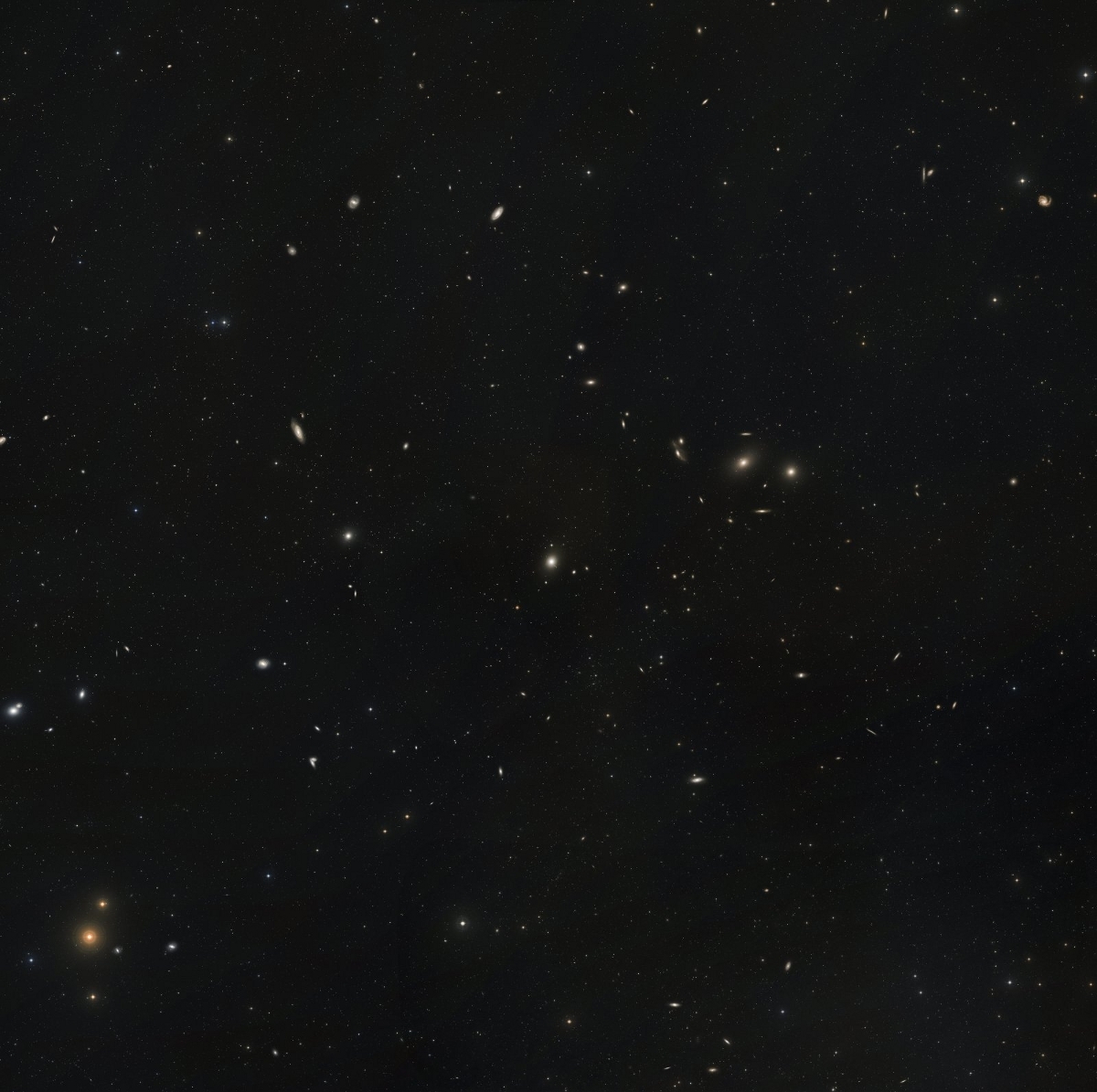
- Anywhere from 100 to 10,000 galaxies, with hot X-ray emitting gas, and extensive dark matter.
- Total masses of 1014 to 1015 solar masses, 80-90% of which is dark matter.
- Diameters range from 1 to 5 Mpc.
- The spread of velocities of the individual galaxies is 800 to 1200 km/s.
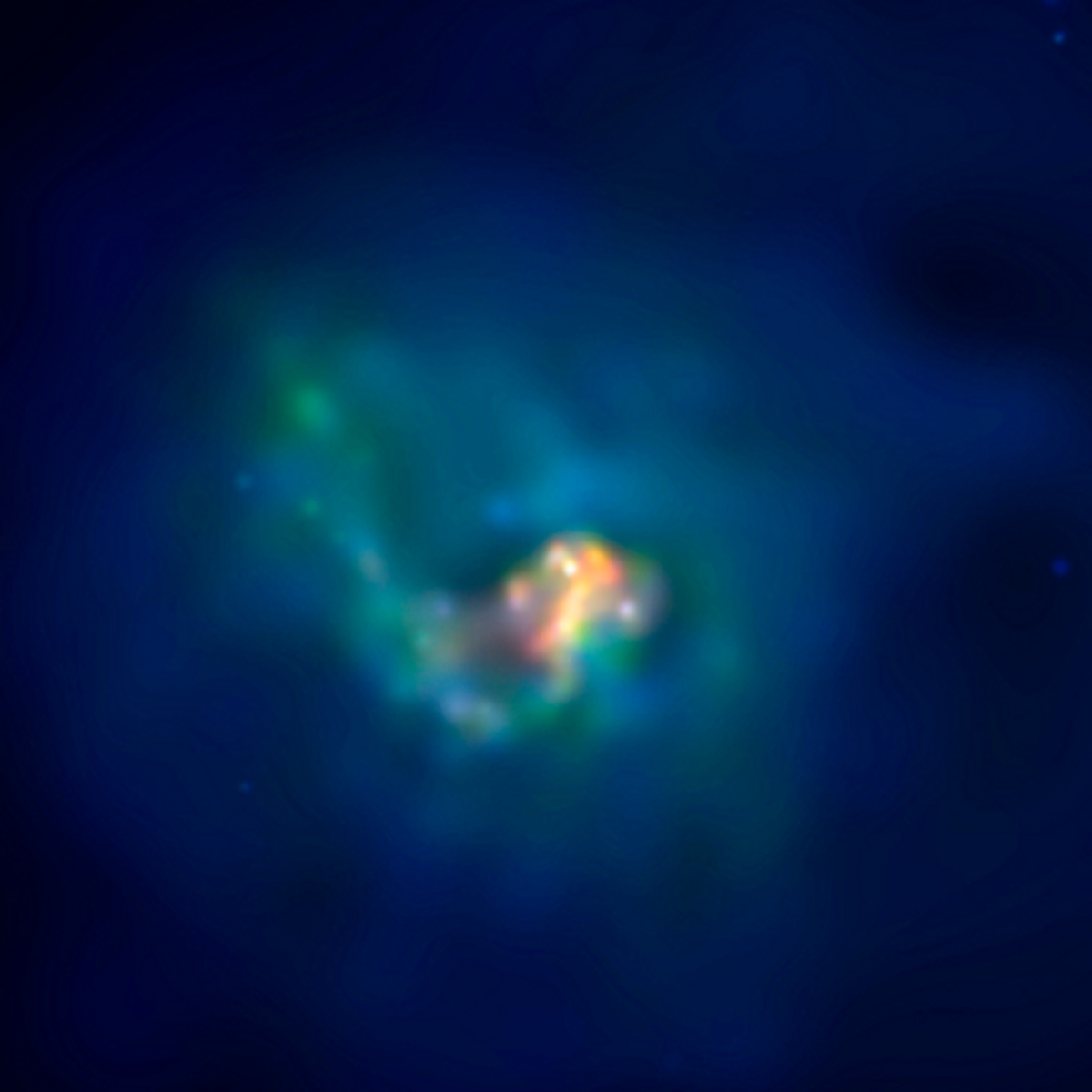
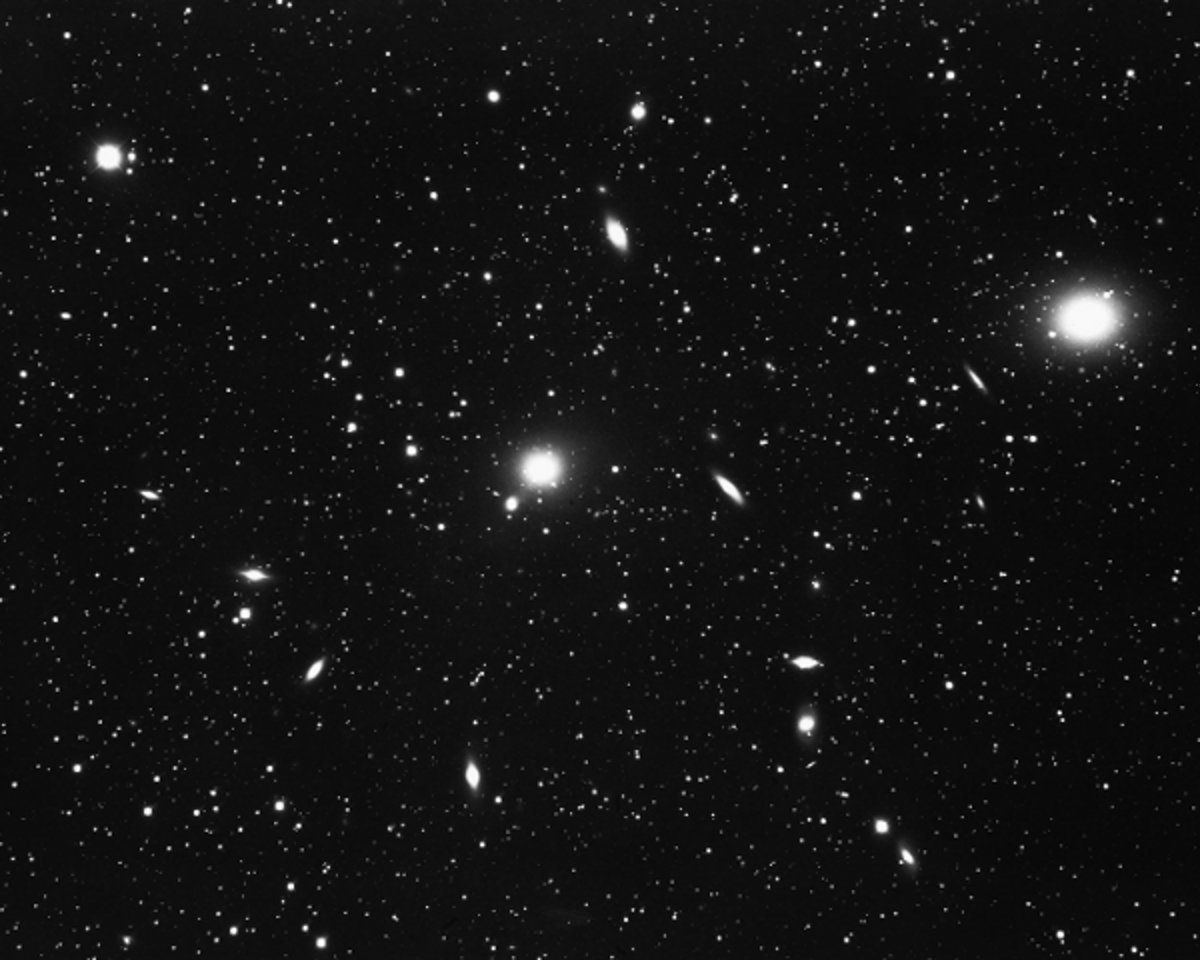
Despite its impressive size, Virgo is considered a poor cluster because it is only 2 or 3 times denser than the Local Group. Poor clusters usually have irregular shapes and a number of subgroups and concentrations within them. The bright galaxies in Virgo are more or less equally divided into spirals and ellipticals. The cluster also has a swarm of hundreds of dwarf galaxies, mostly dwarf ellipticals like those in the Local Group. The Virgo cluster shows up prominently on the map of the brightest galaxies in the sky, along with the Centaurus cluster, which is a cluster of galaxies at a similar distance in the southern sky.
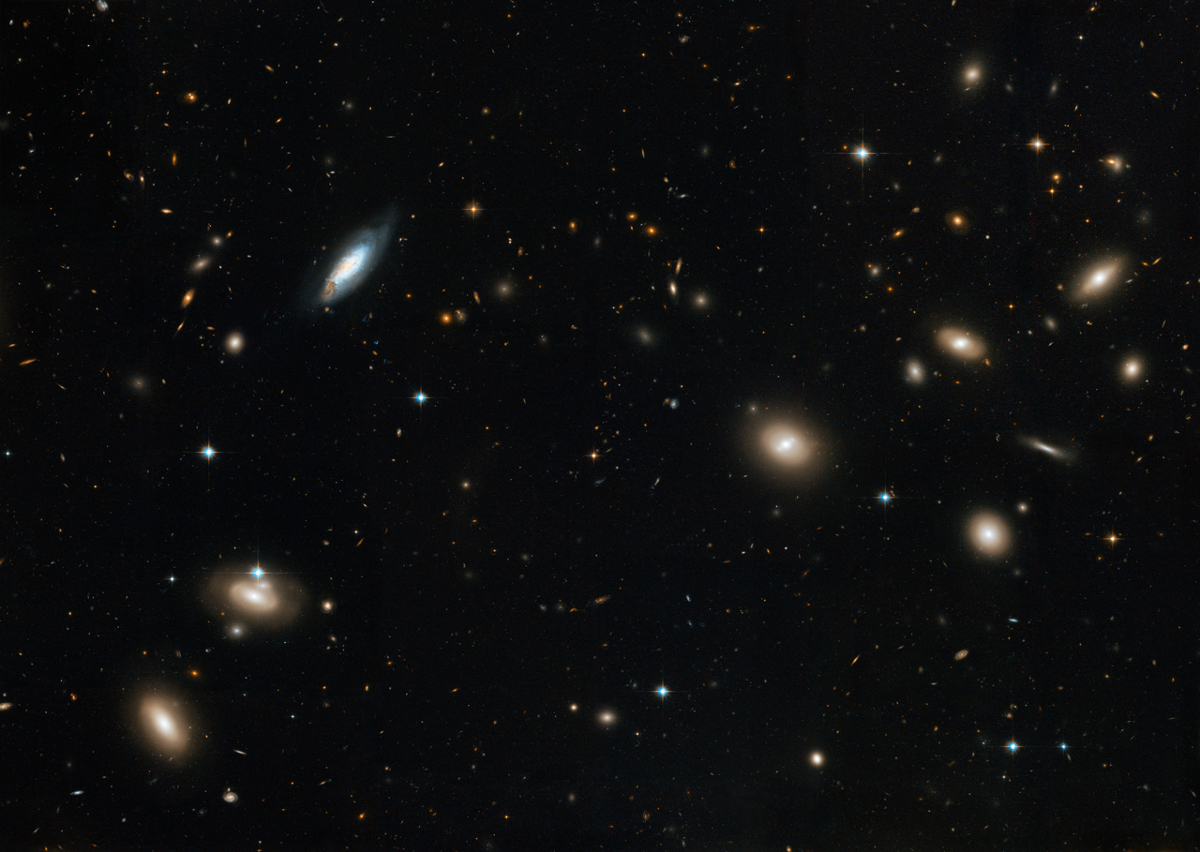
The nearest rich cluster is in the constellation Coma Berenices (Berenice's Hair). The Coma cluster, about 100 Mpc away and about 8 Mpc across, contains thousands of galaxies. At its center are two giant elliptical galaxies. Like most rich clusters, the Coma cluster is spherically symmetric, with a strong central concentration. Most of its galaxies are ellipticals, but it has a moderate number of S0 (or lenticular) galaxies, which are like spirals but without spiral arms and interstellar matter. Only the most luminous galaxies in a cluster appear in CCD images. We are seeing the "tip of the iceberg" of a much larger population of (mostly dwarf) galaxies concentrated in space. The high velocities of Coma cluster galaxies were used by Fritz Zwicky in 1933 to infer the existence of dark matter.
Astronomers have discovered that the relative number of galaxies of different Hubble types in a region depends on the overall density of the environment. This morphology-density relation is a key to understanding how galaxies interact and evolve. Astronomers have measured the relative fraction of spiral, S0, and elliptical galaxies in regions spanning a range of a million in terms of galaxy space density. Below a density of about five galaxies per cubic megaparsec, the fraction of spirals is 60 to 70% and independent of density. Above this density, the spiral fraction drops steadily, until, in the dense cores of the richest clusters (with thousands of galaxies per cubic megaparsec), virtually all the galaxies are S0s, ellipticals, or red spirals. Normal, star-forming, spiral galaxies inhabit low-density regions of the universe and elliptical galaxies inhabit high-density regions of the universe.

Differences in galaxy morphology are reflections of differences in galaxy histories. Many (but perhaps not all) giant elliptical galaxies form through the merging and disruption of spiral systems. The frequency of these two types of galaxies in different environments is a reflection of how often galaxies interact. Astronomers can calculate the time it takes for galaxies to interact in different environments. An interaction is defined as an encounter or close passage where the force of gravity leaves measurable effects on one or both of the galaxies. Below a density of a few galaxies per cubic megaparsec, this time is longer than the age of the universe. Spiral galaxies in low-density regions of the universe are relatively isolated. Thus, they have weak gravitational interactions with other galaxies and rarely experience collisions. Encounters that do occur are gentle, with relative velocities of about 100 to 200 km/s — this is the typical amount of scatter in the Hubble relation. However, at the density of a rich cluster, the time scale for interaction is only a few hundred million years. (Only in astronomy would this sentence use the word only!) There has been time for dozens of interactions in the age of the universe. The strong gravity of a cluster causes the galaxies to have fast motions of 1000 to 1500 km/s. Collisions are relatively frequent and violent.
The morphology-density relation explains some of the puzzles associated with the different galaxy types. Spirals like the Milky Way have too much star formation to be explained by their available reservoir of gas. In fact, spirals get injections of gas from intergalactic space, which is sparsely filled with cold gas. In low-density regions of the universe, this material can fall like gentle rain onto the disks of spiral galaxies, replenishing the gas supply. Spirals are kept young and active by this material. Elliptical galaxies have the opposite problem, with too little star formation. Their old stars lose mass, providing an ample supply of gas. Astronomers believe that as galaxies pass through the dense core of a cluster on high-velocity orbits, they are continually swept free of gas and dust and are structurally disrupted. Additionally, the merger of two spirals that are within a factor of 3 of one another in mass will consistently become elliptical galaxies.
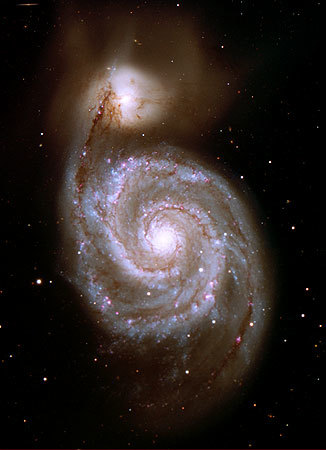
Presumably, the low fraction of spiral galaxies in a cluster results from collisions and mergers that strip away the gas from gas-rich galaxies. At the center of a rich cluster of galaxies, galactic cannibalism has a fascinating effect. Galaxies will gradually merge over time in the cluster core. The result of a large galaxy devouring a number of smaller galaxies could be a giant elliptical. This scenario can explain why the largest galaxies are found at the centers of rich clusters. Interactions, mergers, and collisions cannot explain all of the differences between galaxies. Only a small fraction of galaxies are the remnants of mergers between massive galaxies.
We can understand how rare a galactic merger is if we consider how long it will take for the Milky Way to collide with the Virgo cluster. The Milky Way is about 18 Mpc from the mighty Virgo cluster. We can easily work out how long it would take to fall into Virgo, traveling at 200 km/s. A distance of 18 Mpc is 1.8 × 107 × 3 × 1013 km or 5.4 × 1020 km. Therefore, it would take 5.4 × 1020 / (200 × 3 × 107) = 9 × 1010, or 90 billion years — far longer than the age of the universe — for the Milky Way and the Virgo cluster to merge. Just as in biology, the properties of galaxies are a combination of nature and nurture. Some properties result from evolution or interactions over 12 or 13 billion years. But other features were built in at the beginning so we must look to the early universe to explain many galaxy properties. Astronomers refer to this as the initial conditions. Galaxies evolved out of the unfamiliar conditions of the early universe when it was hot, dense, and smooth.

